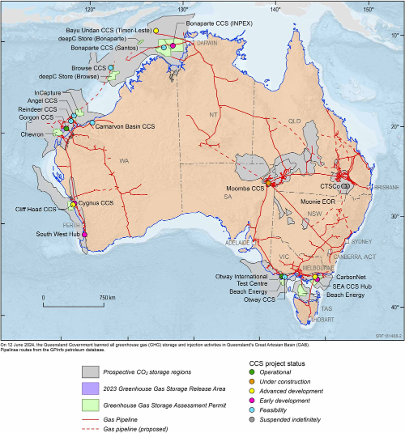What Australian Businesses Need to Know About the Government's Safeguard Mechanism
- Decarbonology
- Jan 30, 2023
- 4 min read
The Australian Government recently announced proposed reforms to its ‘Safeguard Mechanism’, providing much needed clarity on the pathway for businesses to reduce emissions to ensure we meet our net zero targets.
The reforms will take effect on 1 July this year. And while the current proposal only covers some of the country’s largest emitters, it sends a clear signal to industry on where the Government is headed with its climate policy.
It’s only a matter of time before requirements to measure and reduce emissions are rolled out across the broader economy – capturing businesses of all sizes and industries.
Whether for compliance purposes – or demanded by customers, shareholders and investors - all businesses will need to have an emissions reporting and reduction strategy to remain competitive in a decarbonising global economy.

What is the Safeguard Mechanism and How Does it Work?
The Safeguard Mechanism is central to the Government’s plan to cut carbon emissions by 43% from 2005 levels by 2030 and achieve net zero emissions by 2050.
The Mechanism was put in place by the previous Coalition Government and requires facilities that produce over 100,000 tonnes of CO2 equivalent annually to keep their net emissions below a baseline (or cap).
Around 215 facilities in the mining, manufacturing, transport, oil and gas, and waste sectors are currently covered by the scheme. These sites are responsible for around 28% of Australia’s emissions.
Emissions Caps for High Intensity Facilities
Under the Mechanism, the Government will put a cap on the amount of greenhouse gases facilities under the Safeguard can emit. Each facility has a limit - its baseline - and needs to prove that its net emissions for each year are below that baseline.
Under the proposed reforms, emissions baselines set for each facility will be based on emissions intensity, rather than absolute emissions. That means the emissions baseline would rise or fall in line with increases or declines in the plant’s production. This will give facilities time to transition to industry average benchmarks by 2030, at which time the site-specific baselines will be removed.
Facilities that emit more greenhouse gases over their baseline must take action to reduce emissions or buy carbon credits to meet their target.
Carbon Credits to Play a Key Role in Meeting Emissions Reductions Targets
Companies have a variety of compliance options to ensure emissions caps are met.
The most effective strategy is to reduce emissions by doing things like changing industrial processes, improving energy or operating efficiencies, adopting new technologies or using renewable energy.
Facilities that exceed their emissions cap can also purchase carbon credits to hit target. This means they can buy and surrender Australian carbon offsets (ACCUs) to counteract excess emissions. This abatement is additional, meaning it would not have happened as part of business-as-usual activities.
Allowing the use of Australian carbon credits within the Safeguard also supports carbon farming and encourages other emission reduction efforts across the economy.
The price of carbon credits will be fixed initially at $75 per tonne of CO2e in 2023–24, increasing with the CPI plus 2% each year.
The scheme will also create its own Safeguard Mechanism Credits (SMCs), with each credit representing one tonne of carbon dioxide equivalent emissions. SMCs are created within the regulated Safeguard emissions limit—that is, the sum of all baselines under the Safeguard Mechanism.
At the end of a compliance period, if a facility’s actual emissions are less than its baseline, it will be issued with SMCs. This facility can then either sell its credits to another Safeguard facility that emitted more than its own baseline, surrender credits to meet Safeguard compliance obligations, or hold (bank) credits for future use.
Carbon Tariffs on the Table
Following strong stakeholder interest and in the footsteps of Europe, the Government will investigate the potential for a tariff on imported products made with a large carbon footprint from jurisdictions which do not have a carbon price.
This would provide protections for Australian energy intensive trade exposed companies, while also boosting Australia’s reputation as a reliable and secure trading partner.
Some trading partners, including the European Union, have already proposed introducing their own carbon border adjustment mechanisms (CBAMs) placing tariffs on certain high emissions intensive industries and products to help ensure trade competitiveness.
Safeguard Mechanism Consultation Period Still Open
While the reforms represent an important step forward for Australia’s net zero ambitions, there are several items that require greater clarity and consideration during the current consultation period, which closes on February 24.
Aside from the regulatory requirements, a growing number of companies are making emissions reduction commitments to not only reduce their environmental impact, but also to improve operational efficiencies, save money and improve corporate reputation.
Decarbonisation makes good business sense, and those that fail to act could find themselves left behind in the global transition to a low carbon future.
Future Proof Your Business with a Decarbonisation Strategy and Australian Carbon Credits
Decarbonology’s consulting and carbon accounting practice helps businesses of all sizes and industry’s measure their emissions, develop emissions reduction strategies and provide access to Australian and international carbon credit projects.
We can also advise you on your compliance obligations and support you at every stage of your net zero journey.
Contact us to get started on your decarbonisation journey today.




Comments